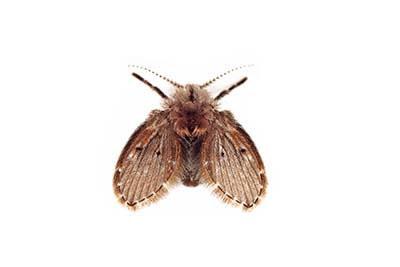Latin Name: Psychodidae

Drain flies are pests that look like moths. They are often called filter flies or sewer flies. You can find them in drains and where there is stagnant water. They don’t bite nor infect humans with diseases. Nonetheless, they can transmit food-borne diseases as they breed in dirty environments.
Their wings and bodies are covered with hairs. When crushed, they leave a powdery smudge. These flies are often confused with fruit fly because you can see them around the drain and stagnant waters. They are poor fliers but walk or run along surfaces.
These pests reproduce in 48 hours, which makes it easy for them to produce.
Drain flies are usually the same size as fruit flies and gnats, about 2-5 mm. However, you can distinguish by their tiny, moth-like wings with their round and fuzzy bodies. They are also different in color from the usual house flies (ranging from pale grey to black). Another critical differentiating trait is the unique pattern of the veins in their wings.
Like house flies, they are used to buzzing around the house and making prominent hops from place to place. They have a pair of wings, antennae with six legs. When they are at rest, the wings fold over their body and form a roof over their body.
They can live up to eight to 24 days and lay and hatch up to 300 eggs in 48 hours. Their larvae are usually about 3/8 long, without legs, and wormlike. They are grey and have darker colors at the end.
Drain flies are mostly found eating organic material in stagnant water, including sewage and other contaminated water. They also feed on food and sewage near animal water, decaying logs, compost, and garbage collection. You can find their larvae feeding on bacteria, fungi, and other microorganisms.
When you first begin to notice those tiny moth-like flies in your kitchen and bathroom, you may not know how much trouble you have in your hands, especially with the thousands breeding in the pipes in your home. However, there are a few ways you can identify where those flies are hiding.
The first method you can try is to place a piece of duct tape on the top of your drain and seal it overnight. Drain flies like to float over the surface, so they will surely come up and get stuck to the tape. This method will indicate any drain pipes to clean. Repeat this method several times to get better results.
One of the things drain flies do often is lay eggs. They lay up to 300 in less than 48 hours. Usually, these eggs build up at the entrance of the drains. How do you find them? Remove the drain cover, scrape the slime off the sides and look for tube-like drain-fly larvae. If you don’t spot any, it is not always a good sign as it can also mean that the eggs may be laid deeper in the soil pores.
Drain flies are not harmful to humans in any way. Although they feed on sewage and bacteria, they also do well with carrying bacteria and disease. When they move in masses, they have diseases and bacteria with them. However, they do not cause any harm to human health.
Before you think they are ok to have around you since they cause no health issues. They reproduce quickly. Thus, filling an area in days and block pipes.
Drain flies live in pools of stagnant water and other organic material. If you want to prevent fly infestation, you must flush your pipes with warm or cold water. In some cases, you may need to wash the pipes frequently. If you are in a situation where you don’t get to use the drains, you should close up the stopper to keep it clean.
Aside from these, watch out for stagnant water in other areas in your home. If you suspect these pests are in or around your home, give us a call for a Free Home Inspection!
